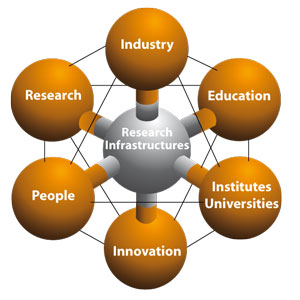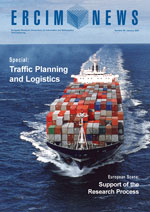In October 2006 the European Strategy Forum for Research Infrastructures (ESFRI) produced its first roadmap. This identifies new Research Infrastructure (RI) of pan-European interest, which will help develop the European Research Area (ERA) over the next ten to twenty years. This has now been handed over for consideration by the Commissioner for Research and the science ministers of the EU member states.
In my letter to them as chair of ESFRI, I state that "Some are evolving projects while others need firm financial commitments from the start. The role of ESFRI in fostering incubation and stimulation will be exercised to bring as many of these projects to a point where decisions by ministers are possible. This requires in the first place, discussions and decisions at national level in particular as regards the lead role one country or several countries may wish to take for certain projects." This point underlines the key role of member states in taking the initiative. Many external observers have cherished the mistaken belief that the roadmap is a list of projects that the EU will fund. The European Commission wishes to aid research and is looking at ways of partly funding the costs of project set-up or development. However, the vast majority of funding must come from member states where they feel a particular project should be of high priority. The process of creating this document is a remarkable achievement, and demonstrates the truly international perspective of most researchers. Nevertheless, a number of issues had to be put to one side in order to deliver a document that would be credible and on time.
One that needs further elaboration is how e-science and computing infrastructure fit with these specific distinct European facilities. Before looking at the implications of this, it is worth reflecting on what ESFRI was set up to do, what it does not do, how it functions and how the roadmap was put together. This will highlight clearly the sort of approach that needs to be integrated with the actions of e-IRG (EC e-Infrastructure Reflection Group) and its future aspirations in developing e-science and supercomputing capability. In February 2002, a high-level expert group comprising representatives from all member states issued a report recommending the creation of ESFRI. Following this, M. Busquin wrote to science ministers of the fifteen member states asking for national nominees to attend the Forum and offering operational support from the Commission.
The first meeting took place in April 2002. Delegates are appointed for a two-year renewable term and must have a direct link to funding bodies and decision makers in their respective countries. In addition, there are observers from potential accession and associate countries, representatives from a number of European organizations, and invited speakers. This means that Forum meetings can have up to a hundred attendees. The Forum's principal objectives are to support a coherent approach to developing policy on research infrastructure in Europe, and to facilitate multi-lateral discussions leading to their better use and development.. The Forum acts as an informal body on issues raised by one or more delegations. It does not make decisions on priorities, funding or the ways in which research infrastructure is subsequently managed. ESFRI gives national authorities the opportunity to be informed of and to explore initiatives concerning the development or upgrading of research infrastructure in areas of European significance. In this way it takes on the role of an incubator. ESFRI is also concerned with other aspects of research development. For instance, it looks at models that have and could be used for pan-European funding and management, at suitable metrics for assessing the value-for-money and socio-economic aspects of such investments, and at how trans-national opportunities for young researchers can best be encouraged. It became apparent in 2004 that a number of countries - European and non-European - were developing long-term (ten to twenty year) roadmaps for research infrastructure. These showed policy makers and funding bodies the areas in which specific research communities aspired to develop, and the approximate funding required. As a result, during the Dutch presidency of the EU, ESFRI was asked to undertake a similar exercise, building on national strategies where possible.

This was a formidable exercise and has dominated the activities of ESFRI until publication. It was decided that all areas of research should be covered including social sciences and humanities. There were discussions on how the exercise should be undertaken. It was decided that three working groups should be set up to investigate specific areas along traditional discipline lines. Many argued for themes such as the environment, pointing out that these cut across disciplines. It was also noted that several areas of research infrastructure supported more than one discipline.
The modus operandi and criteria are fully outlined in the published roadmap. A number of expert groups reporting to the working groups were formed and over a thousand researchers took part in the exercise of analysing proposals. Around two hundred were involved in the peer review of individual projects that were proposed by ESFRI delegates or recognized European organizations. I was delighted by how quickly there emerged a consensus on the key projects that were considered mature enough to be incorporated onto the roadmap, and the final list was unanimously approved by the ESFRI delegates.
For ease of use by policy makers, the areas of infrastructure were subsequently listed under key themes (energy, materials science etc). However, these are somewhat arbitrary, and a series of commentaries is therefore included to elaborate on how each area will contribute to the important challenges facing society. During the construction of the roadmap, discussions started with e-IRG and DG-INFSO on the integration of their developing ideas. Initially it was felt that there might be competition, but with good chairmanship of e-IRG and an openness of ESFRI to get things right, e-IRG delegates attended the Physical Science and Engineering working group. The chair of e-IRG is now permanently invited to the ESFRI meetings.
There is no doubt that the role of e-infrastructure is all pervasive, especially as we move towards remotely driven experiments. However the range of issues is much larger. First, there is the development of massive European databases following population studies, future developments in biosciences and so on. This raises several points. The first surrounds archiving, curation and access to these data. The second relates to verification or provenance, which is a more pressing issue than many realise. The question of how to prove a set of data/metadata is true and has not been corrupted needs to be actively addressed. I often talk about the situation where structural biological data could be corrupted and subsequently used in the design of drugs for field testing. Who will responsible for the millions of euros spent? What about the cost to human lives and to the reputation of the company subsequently employing the results? We do not need to look too far into the recent past to see that data has been published that is untrue. How do we check, who is the final arbiter? As the volume of published data increases, the seriousness of the situation increases. A third point is the linking of simulations with the real-time control of experiments. Some of the infrastructure areas will result in the data flows of millions of pixels on near-femtosecond timescales. As the data comes in it will be necessary to alter the experimental conditions in similar time regimes in order to gain maximum output from a very expensive plant. Computer simulations are required that take in the real data, adapt the models and then issue instructions to the equipment on a time scale of which no human experimenter can conceive. The necessary operating systems, codes and feedback loops need to be developed to ensure that this can take place.
Then we come to the hierarchy of computers needed to support such research. How many supercomputers does the EU need? Here we face the dilemma of juxtaposing the need for capacity (ie a fast number cruncher) with the need for machines designed for specific models. Prof. Tetsuya Sato, the Director-General of the Earth Simulator Center in Japan, argues that both are needed within physical proximity of a few hundred metres. The dedicated machines develop the models which are then handed over to the number crunchers. Is this the right way for Europe? The ESFRI roadmap highlights these issues, but as yet has not resolved them other than to say a hierarchy is needed. The exact words are: "The facility: A European strategic approach to high-performance computing concentrating the resources in a limited number of world top-tier centres in an overall infrastructure connected with associated national, regional and local centres forming a scientific computing network to utilise the top-level machines. This overall architecture will respond both to the Capability (high performance) and Capacity Computing (high throughput) needs. Different machine architectures will fulfil the requirements of different scientific domains and applications. This can be represented as a pyramid where local centres would constitute the base of the pyramid, national and regional centres would constitute the middle layer and the high-end HPC centres would constitute the top." The question that must now be answered is how best to develop and implement these ideas in such a way as to deliver meaningful solutions to European society in the future.
Link:
http://www.cordis.europa.eu/esfri/
Please contact:

E-mail: J.V.Wood










